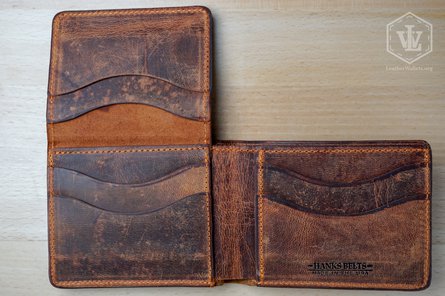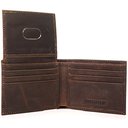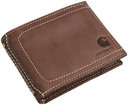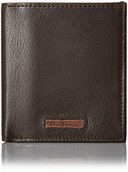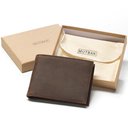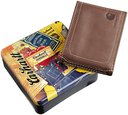What to Consider when Deciding on a Passcase Wallet
What would you say are the most important aspects of a passcase wallet? Do you value durability or do you like the idea of getting a new wallet every couple of years? Do you shop for visual appeal or do you care more about how convenient the passcase is to use?
We’ll tell you how we judge a wallet and point out some of the tricks companies use to sell their products. We trust the information will help you pick out your next passcase as well as give you more insight into the leather goods market.
We’ll start by showing you how you can judge the quality of leather listed in a product description and give you some additional tips if you’re shopping in person. Then, we’ll talk about the secondary materials that make up a wallet, craftsmanship, capacity, features, warranties, and pricing factors.
At the end, you’ll be able to evaluate the quality and value of any leather wallet.
Materials
The materials used to make the passcase wallet are the primary factor in determining how long it will last. The primary material in most wallets we review is leather, but there are a number of other materials that can be used in a leather wallet, from the stitching to the ID window to metal snaps to elastic pull-tabs.
Let’s talk about the different grades of leather and then some leather alternatives before turning our attention to secondary materials that will and might be included.
Leather Quality
Unless you work with leather or have done some research before, you might not know there are different grades of leather. Genuine leather is not really a grade of leather, but is still the most common type found in department stores. Genuine leather is a marketing term and generally refers to leather that has a corrected-grain which includes any bonded leather.
Full-grain and top-grain leather are the top-tier leather grades. The reason is that they’re made from the top layers of an animal’s hide. Genuine or bonded leather is made from the bottom layers of an animal’s hide. You’ll sometimes see it referred to as split leather because the bottom layers are split from the top.
Full and top-grain leather is more durable than genuine or bonded. It also looks like leather. Genuine and bonded leather are actually suede, not leather as you would normally think of it. It looks like leather when you buy it because the manufacturer applies a thick coat of polyurethane over the suede material and stamps it with an artificial texture.
Companies are allowed to call it “genuine” leather because it is leather in a certain sense. It’s from an animal hide. They’re just hoping you don’t what part of the hide it’s from.
Bonded leather is pieces of genuine leather glued back into sheets and cut to shape. It’s scraps that have been bonded back together. Of course, you would never know what a company means when they say “bonded” unless you looked it up.
Both genuine and bonded leather have a very limited lifespan. Not only is the material itself not durable enough to make high-wear goods out of, the polyurethane that they coat it with will only last a year or two. Then, it will crack and peel away from the surface of the “leather.” We’ve probably all seen that type of cracking and peeling on a genuine leather jacket, couch, or truck seat.
The good part about buying genuine leather is that it’s cheap. But is it really worth buying if it’s only going to last 1 or 2 years?
Full and top-grain leather is more expensive, but you get much more life out of them. It’s not uncommon for a full-grain or top-grain wallet to last more than 100 years. And you won’t pay 100 times the price of genuine leather for it. The difference between the two is style. When you buy full-grain, you’re getting an unaltered piece of leather. Each piece is unique because it preserves the natural markings, scars, and pore pattern from the animal’s hide. You’ll see some color variation (especially if the leather is dyed a lighter color), birth and branding marks, scratches or mosquito bite scars, creases, and a non-uniform pore pattern. It makes for a rustic, authentic wallet.
Top-grain leather is the same material with all the natural markings buffed out of it. It can be very smooth or have an artificial pore pattern stamped back into it. It’s for those who want a more “fashionable” look.
You can also find leather imitations for your passcase wallet. Sometimes, it will be called faux leather. Other companies call it koskin or vegan. Like genuine and bonded leather, it’s less expensive than full or top-grain, but it’s also coated in polyurethane that won’t last. The underlying material is cotton or a synthetic material, such as nylon or polyester.
Sometimes, a company doesn’t say what type of leather the wallet is made from. Can you guess which grade they used? If they don’t say, bet on it being genuine or bonded leather. Any company would be proud to name their leather as full or top-grain. And even though faux leather doesn’t last as long, companies who use are proud to be animal-friendly. The only leather grades that don’t have any benefit to them (other than price) is genuine and bonded.
Leather Tanning
Less important than the grade of leather is how the leather was tanned. If you’ve heard your dad say he was going to “tan your hide,” he really wasn’t. He might have turned your cheeks red, but tanning is more than changing the color of a hide. It’s the chemical process of transforming it into leather.
Manufacturers can use plant-based tannins to make vegetable-tanned leather or chromium to make chrome-tanned leather. Thankfully, no one but hobbyists uses brain tanning.
Vegetable-tanned leather takes longer, making it less economical for the company, making it more expensive for you. In this case, though, the higher price doesn’t pay off. Vegetable-tanned leather stains easily when wet. You’ve probably seen leather that looks like it has water soaking into it even when it’s dry. The stain is permanent.
Chrome-tanned leather also stains but a little less easily. It also takes half as long to make.
The bottom line is that you want to be careful not to get your leather passcase wet, but if you want a little extra protection, look for chrome-tanned.
Leather Thickness
You won’t be able to tell this online, but if you’re in the store, you can check the thickness of the leather. You’ll also see Trevor measure the thickness in our review videos.
Even full or top-grain leather will lose its durability if it’s cut too thin. Remember that a hide is separated in layers, so manufacturers have control over how many top or bottom layers they use when making the wallet. Companies who care enough to use full or top-grain leather usually won’t ruin it by cutting it too thin. It’s the genuine and bonded leather wallets that you have to be especially careful of.
If you don’t have a tape measure handy, you can perform two tests to measure the thickness of leather. First, stand it up. If it falls down or sags, it’s too thin. Thick leather keeps its shape and supports its own weight. Second, pinch the layers between your fingers. Feel all along the layer. Do you feel anything in the lining? If the leather is too thin, companies will prop it up with cardboard or thin plastic. It seems like a good idea until you realize that the back side of the thin leather is going to rub against the insert, causing it to wear through even faster.
When Trevor feels something odd between the layers of a wallet, he cuts it up to see what’s inside. Watch the video to see what he finds.
Leather Scent
Ahh… the smell of leather. It’s difficult to describe the scent, but there is a definite odor to leather. Maybe it would be easier to describe what it doesn’t smell like. It doesn’t smell like polyurethane. It doesn’t smell like chemicals. It doesn’t smell like a factory.
If you pick up a leather passcase, it should smell like leather and only leather. Full and top-grain wallets are easy to pick out because they aren’t covered in the thick finishes that genuine, bonded, or faux leather is. But, sometimes, low-grade leather sits for a while and loses its chemical smell. That’s a good thing. Just remember that leather never loses its scent. It will always smell like leather.
It’s funny to watch Trevor smell the wallets we review, especially when he gets one he doesn’t like.
Leather Feel
Like the smell, leather has a certain feel to it. Whether it’s textured or buffed, you can still tell that’s leather. Leather does not feel like wax. It does not feel like plastic. If you find a passcase that feels like either, bet that it’s genuine, bonded, or faux with heavy finishes. Full and top-grain leather will have a light finish that allows you to still feel the texture.
Leather Quality Summary
If it’s covered in polyurethane and doesn’t smell or feel like leather, is there a point to it being leather? Such genuine, bonded, and faux leather passcase are inexpensive but wear very quickly. Full and top-grain leather passcases are more expensive but last for decades with an authentic feel and enduring scent. The only difference between the two is style. Choose full-grain for the look of the hide, top-grain for a more uniform appearance. Vegetable-tanned leather stains more easily than chrome-tanned leather, but not by much.
Nylon
You can also find passcase wallets that aren’t made of leather but nylon. Others feature a leather/nylon combo.
Nylon is a perfectly durable material when it isn’t coated in polyurethane. It’s soft and flexible. The only problem is that it is plastic, so it isn’t as fashionable or as classic as leather. Nylon wallets are popular with woodsy and sporty guys. Some men who prefer leather keep a nylon wallet for outdoor or water activities.
Nylon isn’t water-resistant, but it won’t stain in water either. It’s also less expensive than full or top-grain leather, so it might be worth it to pick one up as a second option.
Construction
Just like a full or top-grain passcase wallet can be ruined with too thin of a cut, it can be ruined by the quality of the stitching, plastic, clips, snaps, zippers, or elastic that might be included in its design. Here’s what to look for and what to avoid.
Stitching
First, take a look at the stitching. It should have two parallel lines close together in a double-stitched pattern or a line of stitching crossing back and forth over itself all the way around each edge. The double or cross-stitch pattern reinforces the stitching as the material of the passcase flexes and cards or cash are inserted in the pockets. Most wallets will have the double-stitched pattern. It’s more subtle. Other companies use cross-stitching as a decorative part of the design of the wallet.
Some manufacturers will list the type of thread they used in the stitching. Nylon and polyester are especially durable. Cotton is a fine but cheaper alternative. The reinforcing sewing pattern is most important with cotton stitching.
Notice how the stitching ends. Is it tied at the end? Looped back under the thread and pulled tight? Those types of finishes won’t hold. The stitching should be melted together at the ends so that they can’t come loose or undone and will keep each other thread its connected to tight.
Lining
In the back of each pocket (and maybe the inside front), there will be some sort of lining. Pigskin or suede would be the most suitable for a leather passcase wallet. Most, however, will be nylon, polyester, cotton, or silk. You’ll need to be especially careful with cloth lining as the rough edge of a card can rip through the material.
More importantly, though, is the stitching pattern inside the pocket. Look down the pocket to ensure that there are not lines of stitching crossing the pocket and that none of the stitches along the side of the pocket are visible from the inside. Cards can snag and pull on exposed stitches.
Plastic and Elastic
Besides stitching and lining, the other necessary material of a passcase is the plastic for the ID window. You can find passcases that don’t have plastic on the window and instead have a simple cutout in the material, but there are very few of them. Just be aware that the plastic is likely to be the least durable material in a full-grain, top-grain, or nylon wallet. The plastic can dent, crack, scratch, and tear away from the lining. The good thing about a passcase wallet is that the plastic is usually kept on the inside of the wallet where it isn’t exposed to as much wear.
You might also find an elastic band around a passcase, forming the pull-tab for a larger inner pocket, or forming one of the pockets itself. Elastic can add a lot of functionality to a wallet. You can have quick-access cash or cards on the outside of the wallet, large or see-through pockets inside, or a way to hold the wallet closed. But elastic is another weak point to watch out for. It can stretch, fray, and tear. When that happens, the functionality that it provides will be useless.
Snaps, Clips, and Chain Rings
Metal can be a useful additive to a passcase. You can use snaps to keep it shut, clips to hold your money more conveniently, and chains to keep it more securely on your person.
But test these components before you buy. Wiggle them back and forth to see how securely they’re attached to the wallet. Test the snaps to see that they connect tightly and won’t come apart without a little force. Look at the stitching around snaps and chain rings to see that the material is tight and reinforced.
If it has a money clip, test how many bills it will hold. Move it back and forth to see how strong the magnets are or how durable the hardware.
Construction Summary
Stitching should be double or cross-stitched with melted ends. Lining should be made of a durable material, such as suede, pigskin, nylon, or polyester with no stitching exposed in the pocket. Plastic and elastic should be protected from wear and not used for a function in which it will likely stretch out. Hardware should be strong and securely attached with little movement. Zippers should close fully with tight connections and reinforced stitching.
Craftsmanship
The craftsmanship of the wallet deals with how well the craftsmen and craftswomen did their job. Did they cut and sew the lines properly? Did they finish the edges and corners to provide the best durability or did they take shortcuts?
Cuts and Lines
When you follow each cut and stitching line with your eye, they should all appear straight and angled parallel or perpendicular relative to the rest of the wallet. You don’t want to see wavy lines or odd angles unless it’s an obvious part of the passcase’s design. Stitching should appear uniform with even lines between each hole.
Pocket Edges
Pockets will either have cut-off tops, folded over tops, or front-rolled tops. All of them are suitable finishing styles, provided they’re done correctly.
If you see a cut-off top, check the thickness of the leather. The pocket should be thick enough to stay rigid across the top with no cards in it.
Fold-overs should not stop near the top of the pocket. Cards can catch on high fold-overs, making it irritating for you pull your cards out and eventually pulling the stitching for the fold loose.
Rolled edges take some time and skill. The material at the top of the pocket has to be thin enough to roll over. The best pockets are made of thick material with only the tops thinned. If the rest of the pocket isn’t thick enough, the rollover is a decorative touch, but the pockets themselves won’t be very durable.
Wallet Edges
Like thinning pocket tops to create a rollover, each layer should also be thinned where they meet the outer edge of the wallet. Thinning the edges will help make a smooth surface all the way down the wallet. If the edges have not been thinned, you’ll see each layer stacked on top of the previous layer, forming the next step in a staircase.
The edges should also be turned or folded in away from the edge so that you can’t see the cut. Turning the edges makes the wallet more durable.
What you don’t want to see is a dark coating on the edges of the wallet. Any type of coating anywhere on the wallet is a shortcut. In this case, it covers up edges that haven’t been thinned or turned. And like the coating used on genuine, bonded, and faux leather, it will quickly begin to dry and peel away from the leather.
Corners
Like the edges, the corners should also be thinned so that they can fold down into a rounded shape. Square corners are a shortcut that doesn’t do you any favors. The corners catch on your pants pocket and wear faster than they should. Rounded corners glide in more easily.
When you look at the sewing pattern around your corner, you should see the leather material bunched up like an accordion or an open curtain. It’s called pleating. The advantage is that it doesn’t remove any of the material from the corner and makes it stronger with more material sewn onto the interior fold.
Craftsmanship Summary
Cuts and lines should be straight. Cut, folded, or rolled pockets should still be of sufficient thickness. Folds should extend at least halfway down the pocket. Edges should be folded in and blend together down the interior of the wallet. Corners should be rounded and pleated.
Warranty
Most people don’t pay much attention to the terms of a warranty unless they’re buying a vehicle or major appliance. But warranties can clue you in on how confident a company is about its product.
Some companies, for instance, don’t offer any warranty beyond the required 30-day return window. You have to wonder why they’re not offering a warranty. Are they so confident in their product that they’re sure it will never fail? Or do they simply want to avoid being held responsible when it does fail?
Warranties that last only a few months are a sure sign that the companies don’t think the product will last longer than that. You’ll see very short warranties with genuine, bonded, or faux leather. They know that the polyurethane will fail sooner than later and don’t want to replace the wallet when it does.
Others are happy to offer money-back guarantees, no questions asked for the life of the wallet. They offer the guarantee so that you’ll feel confident enough to buy the product. You reason that you can always return it if it doesn’t work out. But how many people actually return the wallet and request a refund? The company knows that if they can sell you an inexpensive wallet, you won’t go through the hassle of returning it. They’re saying, “Sure, we’ll refund your money, but you’ll never get around to asking for it.”
On the opposite end of the warranty spectrum are companies who offer lifetime warranties or 100-year warranties. The message is that they stand by their product and that you can expect it to last that long. But is a 100-year warranty of any practical value? Who would send a wallet back after 50 years to have the stitching tightened?
One to three years is a reasonable amount of time for a wallet. It will give you the opportunity to use your passcase on a daily basis and notice if there’s anything wrong with the materials or craftsmanship. If you can’t find anything wrong by then, you and the company can fairly consider the deal closed. They’ve made a high-quality wallet that you can feel confident about getting your money’s worth out of.
Size and Weight
A passcase wallet will be thicker than a regular bifold, but it doesn’t need to be wider or taller. Look for one that measures approximately 4.5” x 3.5”. The 3.5-inch width will allow you to comfortably fit your bills in the cash pocket without folding them and the 4.5-inch height will provide enough space for 3 card slots on each side of the interior. That size will fit well in your back pocket, in your shirt pocket, or in the pocket of your suit jacket. You could even put it in your front pants pocket if you don’t mind the extra thickness from the passcase flap.
Because it does have the flap, a passcase wallet should weigh between 40 and 100 grams. That weight will represent sufficiently thick leather layers while not being so heavy as to weigh down your clothes.
Capacity
A passcase should hold more than other bifold designs because it can include card slots on the back of the flap. Plan how much cash you want to be able to carry and how many of the different types of cards you need to keep in your wallet. Purchasing a new passcase is a great opportunity to clean out and reduce what you keep in your wallet.
When you have your wallet contents down to the essentials for your particular lifestyle, try fitting them in the passcase before you buy it. You might find that it doesn’t comfortably hold as much as the packaging says it will. You might also find that the placement of the pockets won’t be as convenient as you would like.
In our review videos, Trevor tests each pocket and identifies the issues you might have with the design.
The flap on a passcase wallet is especially important. Think about how you want it to open. Do you want it to open to the side or from the top? Do you want card slots on the back or would you rather have the back plain?
Features
Besides the flap and cash and card pockets, are you looking for any additional features in a passcase wallet? Do you want zippers or snaps? Would you rather it have a money clip instead of a cash pocket? Do you want it to have a divider in the cash pocket? Do you need a coin or key pouch? Do you like quick-access elastic or pull-tabs?
Every design is a little different, and with so many companies making wallets, there’s no reason to settle for something less than your ideal.
RFID Protection
One feature we do encourage you to look for is RFID protection. RFID (radio frequency identification) is the technology used to read bank, credit, and key cards. When you insert your card or hold it up to a reader, it accesses your encoded information via radio frequencies.
The danger is that you don’t need to voluntarily insert your card or hold it up to a reader. Nefarious fellows with a scanner can access your information while your cards are still in your wallet in your pocket. Clothing and leather do nothing to block the radio frequencies.
You need a metallic insert between the layers of your wallet. The metallic mesh isn’t hard, and it doesn’t support your wallet as cardboard or plastic inserts do. It’s a flexible material that blocks the radio frequencies.
You should know that there are two different frequencies and that some wallets only block one or only block the frequencies in certain pockets. This allows you to continue using key cards and EZ pass cards through your wallet if you want to. The two frequencies are 13.56 MHz for financial and personal information and 125 kHz for key and pass cards.
You can also use separate sleeves for your cards that will block radio frequencies. Adding sleeves to your cards, however, will make them bulkier, so you won’t be able to fit as many cards into each pocket as you might like.
Design
The design of a wallet includes the imprinted company logo. Some people enjoy sporting the brand names of their favorite clothing and accessory companies. Others prefer not to offer free advertising by making themselves a billboard. You probably won’t find a wallet without a company logo somewhere on the wallet, but you can choose whether you want it to be a large part of the exterior design or a subtle signature on the interior.
You can also find passcase wallets with printed or embossed designs. Our only caution is to consider how long you will like the design and whether the design is one that you would feel comfortable showing on any occasion. You never know who you might be with when you need to pull your wallet out and pay for something.
Purchase Options
Leather is a classy and classic material. The most common colors are black and dark brown. That doesn’t mean that you have to settle for those same colors though. Many companies take advantage of the fact that you can dye leather and nylon any color. Look for a passcase wallet that comes in multiple colors so that you can choose the one you want.
Just remember that certain colors might not be appropriate for all occasions.
Packaging and Gift Boxes
Have you ever had to return an item because the product was damaged in shipping? It’s a hassle. Try to avoid the trouble with your passcase by asking how it will be shipped to you. Our review videos show the unboxing so that you can see how well the wallet was packaged. Ideally, a wallet should be packed in its own smaller box inside a larger box stuffed with peanuts, crumpled paper, or air pouches.
If you’re buying the passcase as a gift for someone, you might also want to get a picture of the box it comes in. Some companies advertise a gift box as part of the product description. That term can mean anything from a plain box that you have to wrap to a decorative box perfectly presentable on its own.
Price
So, how much should you pay for a passcase wallet?
If you’re buying genuine, bonded, or faux leather, you shouldn’t have to pay any more than $15. The durability and material cost isn’t there to warrant any higher of a price. Nylon wallets will also be in the same price range.
Full and top-grain leather passcases can be fairly priced between $40 and $80. Anything more expensive won’t be any higher quality. It will just cost more for branding. The name on a wallet is an intangible feature that doesn’t add any real value to the product. You might like the brand and want to support it, but you’re not getting anything else out of it that you wouldn’t from another wallet of equal quality.
Our advice is to judge a passcase by the above signs of material durability, construction, craftsmanship, features, and design, not the company who made it.
Conclusion
Which wallet is the best? Let’s summarize. The Hanks, Mutbak, and Carhartt designs are all in the same class of durability with rugged appeal. The Hanks is the most expensive of the three. The Mutbak has higher capacity, but the Carhartt doesn’t have card slots on the ID window flap. The Bosca Dolce is less durable but designed for higher fashion, and the Ben Sherman is the toned down model with a distinctive side-flap at a fraction of the cost.
